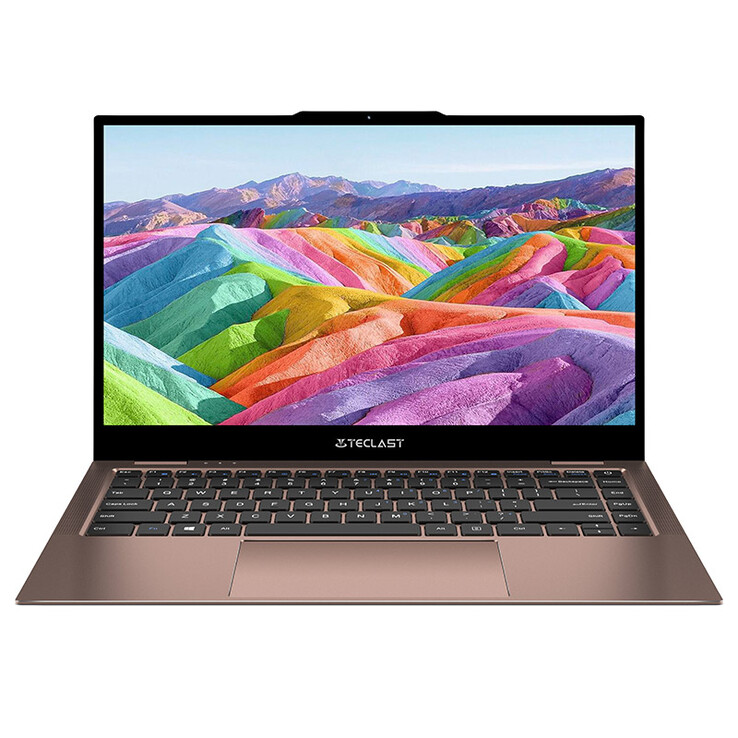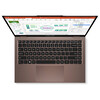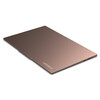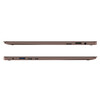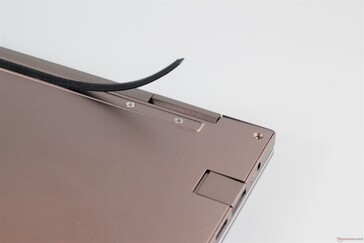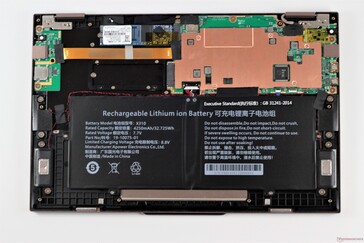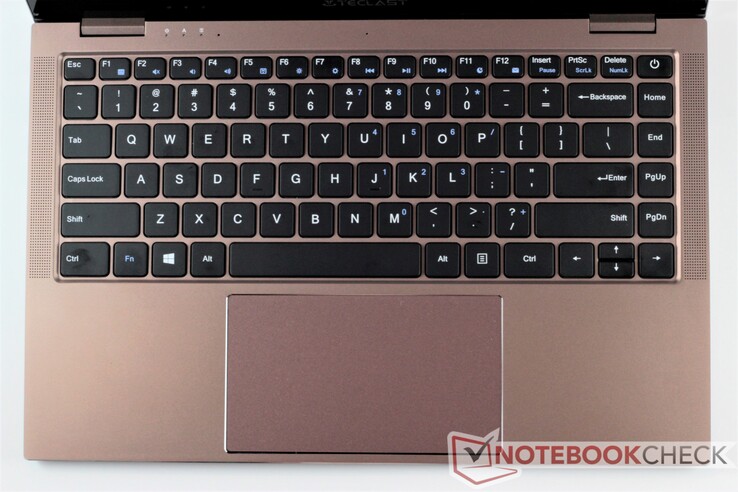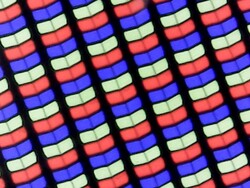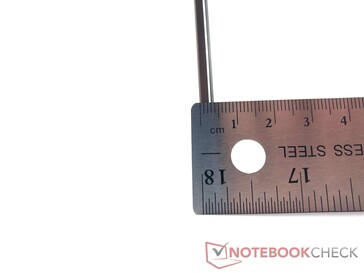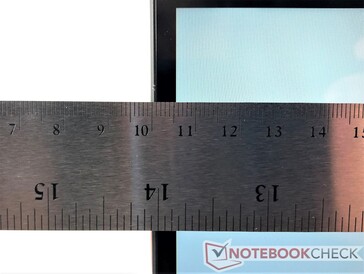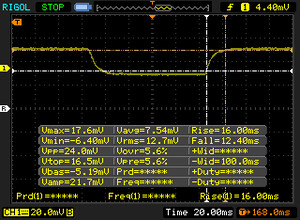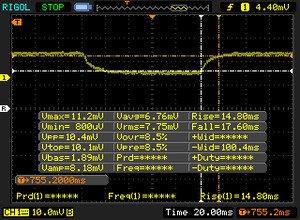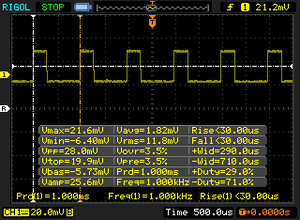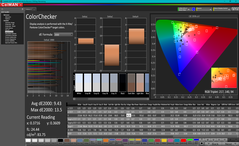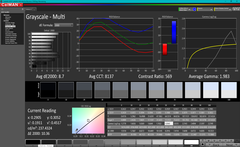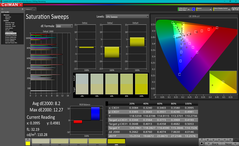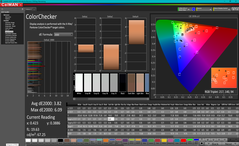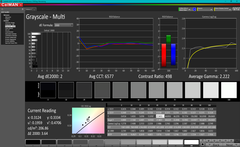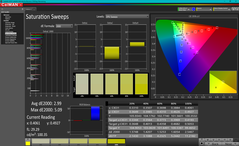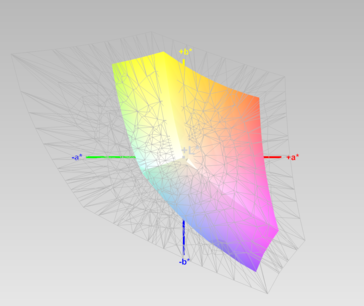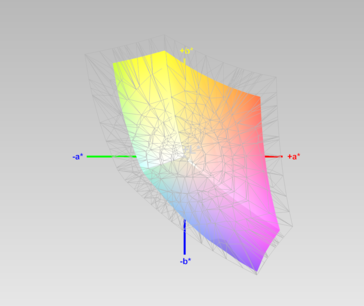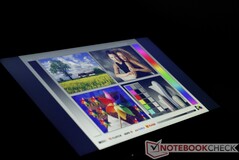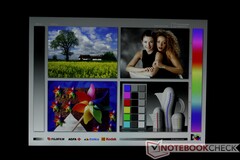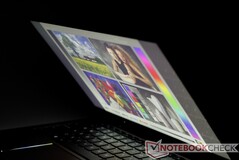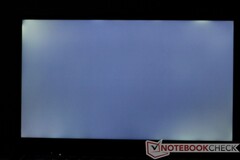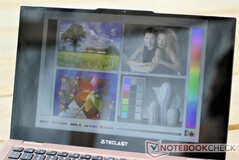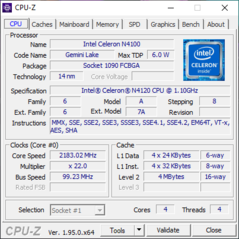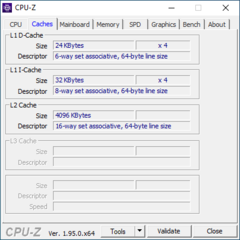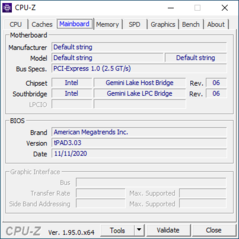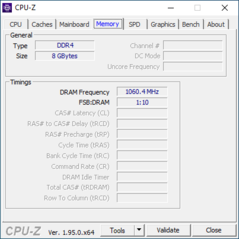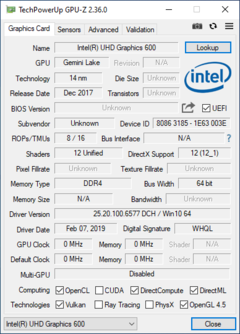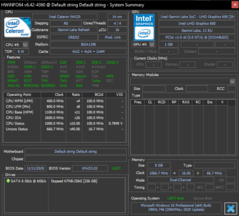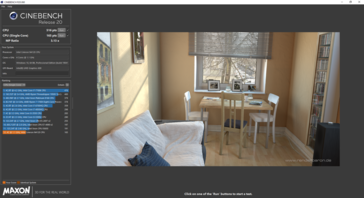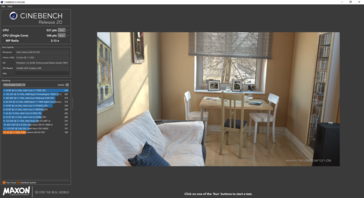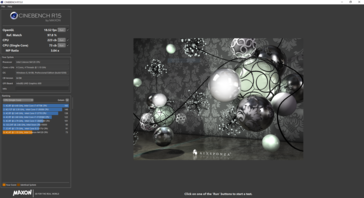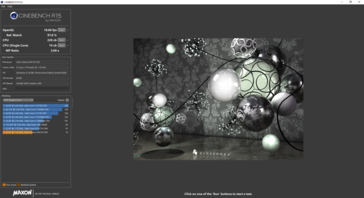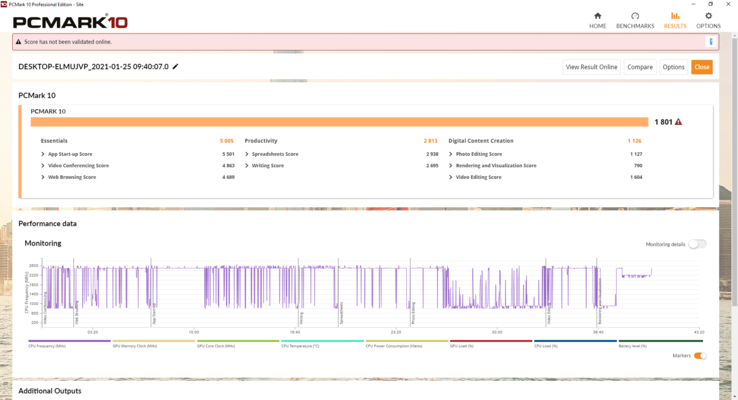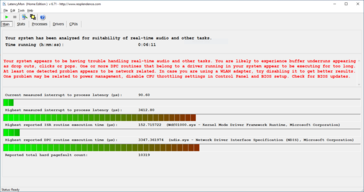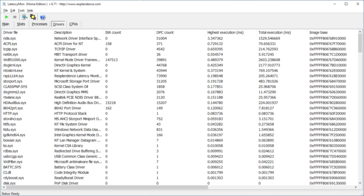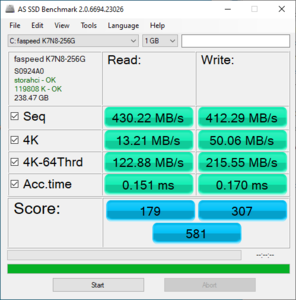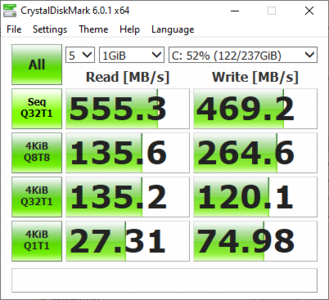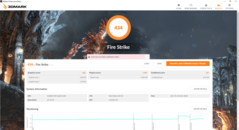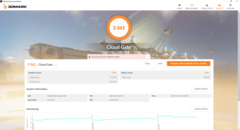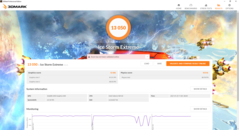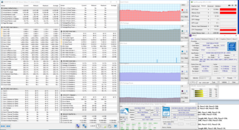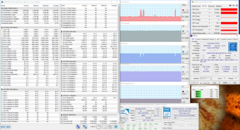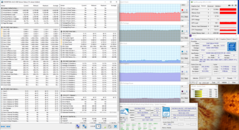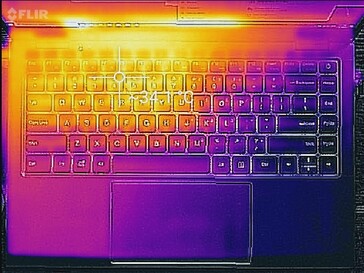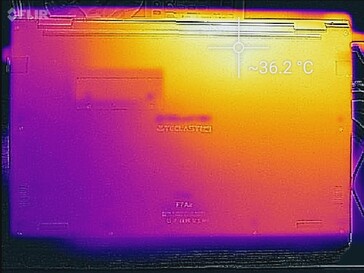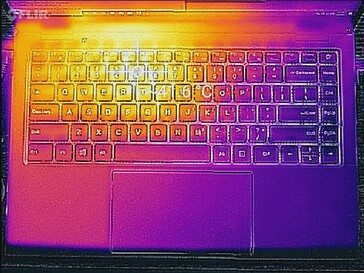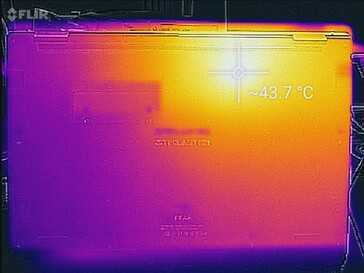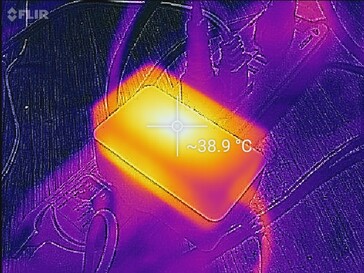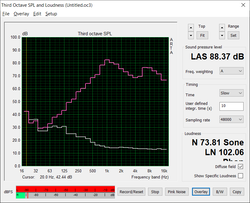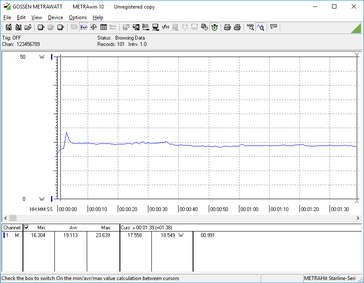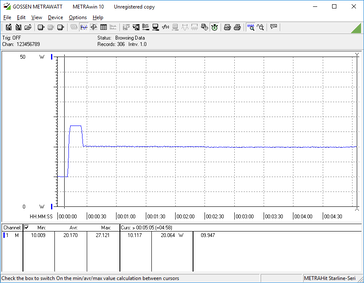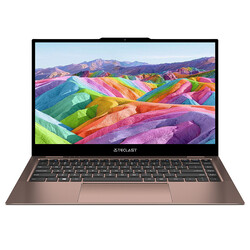Teclast F7 Air Laptop Revisão

A Teclast é um dos muitos fabricantes chineses com uma grande seleção de laptops e tabletes com boa aparência e custo-benefício. O F7 Air de 14 polegadas cabe bem nessa descrição com um perfil fino, um corpo de alumínio bem trabalhado e um estilo premium. Entretanto, como a maioria dos laptops chineses de baixo custo, o F7 Air oferece pouco em termos de desempenho bruto
Se o F7 Air parece familiar, é porque tem uma semelhança marcante com o LarkBook CWI509 de 13,3 polegadas ligeiramente menor de Chuwi. A principal diferença entre os dois é o display maior de 14 polegadas da F7 Air. A F7 Air também leva pistas de design das linhas Apple's MacBook e MacBook Pro. Veremos se a F7 Air pode lidar com as exigências atuais da computação ou se sua beleza é apenas superficial.
A Teclast F7 Air compete com outros portáteis compactos e de baixa potência como o já mencionado Chuwi LarkBook, o Chuwi AeroBook Pro, o Chuwi LapBook Pro, o Swift 3 e Aspire 1 da Acer, e o Medion Akoya E4253
potential competitors in comparison
Avaliação | Data | Modelo | Peso | Altura | Size | Resolução | Preço |
|---|---|---|---|---|---|---|---|
| 75.4 % v7 (old) | 02/2021 | Teclast F7 Air Celeron N4120, UHD Graphics 600 | 1.2 kg | 17 mm | 14.00" | 1920x1080 | |
| 76.9 % v7 (old) | 01/2021 | Chuwi LarkBook CWI509 Celeron N4120, UHD Graphics 600 | 1.1 kg | 12.3 mm | 13.30" | 1920x1080 | |
| 78.7 % v7 (old) | 08/2019 | Chuwi LapBook Pro Celeron N4100, UHD Graphics 600 | 1.4 kg | 13.4 mm | 14.00" | 1920x1080 | |
| 77.7 % v7 (old) | 06/2020 | Chuwi AeroBook Pro m3-8100Y, UHD Graphics 615 | 1.3 kg | 15.2 mm | 13.30" | 1920x1080 | |
| 72.5 % v7 (old) | 03/2020 | Acer Aspire 1 A114-32-P0K1 Pentium N5000, UHD Graphics 605 | 1.7 kg | 17.95 mm | 14.00" | 1920x1080 | |
| 85 % v7 (old) | 09/2020 | Acer Swift 3 SF314-42-R27B R3 4300U, Vega 5 | 1.2 kg | 16.55 mm | 14.00" | 1920x1080 | |
| 79.9 % v7 (old) | Medion Akoya E4253-30025387 Pentium N5000, UHD Graphics 605 | 1.4 kg | 15 mm | 14.00" | 1920x1080 |
Os Top 10
» Os Top 10 Portáteis Multimídia
» Os Top 10 Portáteis de Jogos
» Os Top 10 Portáteis Leves para Jogos
» Os Top 10 Portáteis Acessíveis de Escritório/Empresariais
» Os Top 10 Portáteis Premium de Escritório/Empresariais
» Os Top 10 dos Portáteis Workstation
» Os Top 10 Subportáteis
» Os Top 10 Ultrabooks
» Os Top 10 Conversíveis
» Os Top 10 Tablets
» Os Top 10 Smartphones
» A melhores Telas de Portáteis Analisadas Pela Notebookcheck
» Top 10 dos portáteis abaixo dos 500 Euros da Notebookcheck
» Top 10 dos Portáteis abaixo dos 300 Euros
Estojo e Conectividade
O Teclast F7 Air perfura bem acima de seu peso em termos de aparência. O corpo de alumínio parece e sente-se fantástico, e a cor dourada dá um belo estalo de cor. O acabamento escovado mascara bem as impressões digitais. O chassi é robusto e sólido. Há alguma flexibilidade ao longo do deck do teclado, mas não é perceptível durante a digitação. Apesar de seu fino perfil de 5mm, a tampa é robusta e não torce. As dobradiças são muito rígidas para uma abertura com uma mão, mas mantêm o visor no lugar.
Nossa queixa principal reside nas folgas irregulares ao redor do trackpad e da borda frontal do painel inferior. No entanto, estas são pequenas picareta; a qualidade de construção e a estética são ótimas. À primeira vista, o F7 Air parece mais parecido com os laptops que custam US$1000 ou mais.
A conectividade é adequada. Os dois USB-A (um 3.1 Gen 1, o outro 2.0) têm pequenas abas que se dobram para acomodar o perfil fino do laptop. Estes parecem mal feitos, mas aguentaram até vários plug-ins durante duas semanas. Há também uma mini porta HDMI, portanto alguns usuários podem precisar de um adaptador. A porta USB-C 3.1 Gen 1 pode ser usada para carregar o dispositivo e suporta a exibição via DisplayPort 1.2 (4K @ 30 Hz, FHD @ 120 Hz)
Conectividade
| SD Card Reader | |
| average JPG Copy Test (av. of 3 runs) | |
| Acer Aspire 1 A114-32-P0K1 (Toshiba Exceria Pro SDXC 64 GB UHS-II) | |
| Média da turma Subnotebook (18.4 - 142, n=14, últimos 2 anos) | |
| Chuwi AeroBook Pro (Toshiba Exceria Pro M501 64 GB UHS-II) | |
| Teclast F7 Air (Toshiba Exceria Pro M501 UHS-II) | |
| Chuwi LarkBook CWI509 (Toshiba Exceria Pro M501 32 GB UHS-II) | |
| maximum AS SSD Seq Read Test (1GB) | |
| Acer Aspire 1 A114-32-P0K1 (Toshiba Exceria Pro SDXC 64 GB UHS-II) | |
| Média da turma Subnotebook (22.5 - 207, n=14, últimos 2 anos) | |
| Medion Akoya E4253-30025387 (Toshiba Exceria Pro M501 microSDXC 64GB) | |
| Chuwi AeroBook Pro (Toshiba Exceria Pro M501 64 GB UHS-II) | |
| Teclast F7 Air (Toshiba Exceria Pro M501 UHS-II) | |
| Chuwi LarkBook CWI509 (Toshiba Exceria Pro M501 32 GB UHS-II) | |
| Networking | |
| iperf3 transmit AX12 | |
| Acer Swift 3 SF314-42-R27B | |
| Medion Akoya E4253-30025387 | |
| Acer Aspire 1 A114-32-P0K1 | |
| Chuwi LapBook Pro | |
| Chuwi LarkBook CWI509 | |
| Chuwi AeroBook Pro | |
| Teclast F7 Air | |
| iperf3 receive AX12 | |
| Acer Swift 3 SF314-42-R27B | |
| Medion Akoya E4253-30025387 | |
| Acer Aspire 1 A114-32-P0K1 | |
| Chuwi AeroBook Pro | |
| Chuwi LapBook Pro | |
| Chuwi LarkBook CWI509 | |
| Teclast F7 Air | |
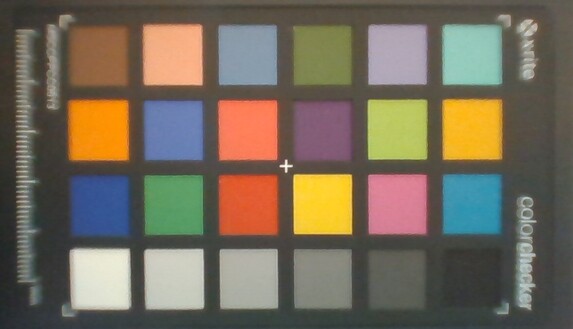
Manutenção
Depois de remover 14 parafusos Phillips Heads, o painel inferior pode ser destravado e removido. Os usuários podem atualizar somente os dois drives M.2 2280 SATA; todos os outros componentes são soldados à placa principal. Felizmente, existe um painel de acesso prático para chegar a um dos baías SATA
Dispositivos de entrada
O teclado é adequado. Parece e parece um teclado genérico de laptop. As teclas alfanuméricas estão no lado pequeno (~16 mm2). A distância de viagem é decente, mas o ponto de pressão é suave. Como resultado, as teclas sentem-se esponjosas. O clatter é perceptível, mas não intrusivo. Caso contrário, não há nada de extraordinário no teclado. O teclado não tem retroiluminação
O clickpad é bastante bom. Ele oferece uma grande superfície (12,8 x 7,3 cm) com uma superfície lustrosa que oferece um deslizamento suave. O rastreamento é preciso, e o mecanismo de clique não causa nenhuma reclamação. Entretanto, os gestos são descuidados; a rolagem com dois dedos às vezes resulta em um zoom para dentro ou para fora de uma janela aberta, o que é frustrante. Como mencionado, há algumas lacunas irregulares ao longo da borda do trackpad, embora estas não afetem a experiência
Mostrar
O display é um saco misto. O painel FHD de 14 polegadas é crocante e parece razoavelmente vibrante graças ao acabamento brilhante, mas a luz de fundo em geral é bastante fraca (234 lêndeas). Além disso, os níveis de preto são relativamente pobres (0,46), resultando em uma relação de baixo contraste (512:1). A causa principal para isto é o alto brilho mínimo da luz de fundo; mesmo em seu nível mais baixo, a luz de fundo ainda brilha a cerca de 70 cd/m², o que é um pouco mais brilhante do que a maioria dos laptops. Como tal, o F7 Air não é adequado para uso em ambientes escuros; a alta luminosidade mínima pode cansar os olhos
Caso contrário, o painel é bom. Ele oferece tempos médios de resposta para uma tela IPS e tem PWM decentemente alto (1000 Hz), especialmente em comparação com outros laptops chineses de baixo custo
| |||||||||||||||||||||||||
iluminação: 78 %
iluminação com acumulador: 235.6 cd/m²
Contraste: 512:1 (Preto: 0.46 cd/m²)
ΔE ColorChecker Calman: 9.43 | ∀{0.5-29.43 Ø4.78}
calibrated: 3.82
ΔE Greyscale Calman: 8.7 | ∀{0.09-98 Ø5}
69% sRGB (Argyll 1.6.3 3D)
44% AdobeRGB 1998 (Argyll 1.6.3 3D)
47.08% AdobeRGB 1998 (Argyll 3D)
68.7% sRGB (Argyll 3D)
45.57% Display P3 (Argyll 3D)
Gamma: 1.983
CCT: 8137 K
| Teclast F7 Air 1920x1080, 14" | Chuwi LarkBook CWI509 M133X56, , 1920x1080, 13.3" | Chuwi LapBook Pro BOE CQ HV140FHNM-N61, , 1920x1080, 14" | Chuwi AeroBook Pro BOE NV133FHM-N6A, , 1920x1080, 13.3" | Acer Aspire 1 A114-32-P0K1 Chi Mei N140HGE-EAA, , 1920x1080, 14" | Acer Swift 3 SF314-42-R27B AU Optronics B140HAN04.0, , 1920x1080, 14" | Medion Akoya E4253-30025387 Chi Mei N140HCA-EAB, , 1920x1080, 14" | |
|---|---|---|---|---|---|---|---|
| Display | 44% | 50% | 39% | -11% | -17% | -10% | |
| Display P3 Coverage (%) | 45.57 | 69.9 53% | 73 60% | 68.7 51% | 40.35 -11% | 37.78 -17% | 40.96 -10% |
| sRGB Coverage (%) | 68.7 | 92.7 35% | 96.1 40% | 88 28% | 60.3 -12% | 56.8 -17% | 61.1 -11% |
| AdobeRGB 1998 Coverage (%) | 47.08 | 67.8 44% | 70.3 49% | 64.4 37% | 41.71 -11% | 39.03 -17% | 42.37 -10% |
| Response Times | -10% | -16% | -5% | 11% | -15% | -15% | |
| Response Time Grey 50% / Grey 80% * (ms) | 32.4 ? | 32 ? 1% | 42 ? -30% | 31 ? 4% | 43 ? -33% | 42 ? -30% | 42 ? -30% |
| Response Time Black / White * (ms) | 28.4 ? | 34.4 ? -21% | 29 ? -2% | 32 ? -13% | 13 ? 54% | 28 ? 1% | 28 ? 1% |
| PWM Frequency (Hz) | 1000 ? | 1000 ? | 200 ? | 201.6 ? | 250 ? | 24500 ? | |
| Screen | 20% | 18% | 21% | -18% | 24% | 10% | |
| Brightness middle (cd/m²) | 235.6 | 235.3 0% | 297 26% | 242.3 3% | 208 -12% | 256 9% | 262 11% |
| Brightness (cd/m²) | 234 | 223 -5% | 268 15% | 233 0% | 192 -18% | 237 1% | 242 3% |
| Brightness Distribution (%) | 78 | 79 1% | 77 -1% | 88 13% | 85 9% | 81 4% | 87 12% |
| Black Level * (cd/m²) | 0.46 | 0.24 48% | 0.625 -36% | 0.31 33% | 0.41 11% | 0.17 63% | 0.505 -10% |
| Contrast (:1) | 512 | 980 91% | 475 -7% | 782 53% | 507 -1% | 1506 194% | 519 1% |
| Colorchecker dE 2000 * | 9.43 | 8.37 11% | 5.23 45% | 6.72 29% | 10.1 -7% | 5.43 42% | 5.49 42% |
| Colorchecker dE 2000 max. * | 13.5 | 15.79 -17% | 9.53 29% | 11.67 14% | 28.85 -114% | 19.73 -46% | 10.63 21% |
| Colorchecker dE 2000 calibrated * | 3.82 | 2.64 31% | 3.95 -3% | 4.38 -15% | 4.8 -26% | ||
| Greyscale dE 2000 * | 8.7 | 9.8 -13% | 6.72 23% | 6 31% | 10.96 -26% | 3.29 62% | 4.84 44% |
| Gamma | 1.983 111% | 2.16 102% | 2.38 92% | 2.18 101% | 2.24 98% | 2.52 87% | 2.3 96% |
| CCT | 8137 80% | 7557 86% | 7015 93% | 7159 91% | 11669 56% | 6840 95% | 6347 102% |
| Color Space (Percent of AdobeRGB 1998) (%) | 44 | 60.1 37% | 63 43% | 57.5 31% | 38 -14% | 36 -18% | 39 -11% |
| Color Space (Percent of sRGB) (%) | 69 | 92.4 34% | 96 39% | 87.7 27% | 59 -14% | 57 -17% | 61 -12% |
| Média Total (Programa/Configurações) | 18% /
21% | 17% /
20% | 18% /
21% | -6% /
-13% | -3% /
12% | -5% /
3% |
* ... menor é melhor
Exibir tempos de resposta
| ↔ Tempo de resposta preto para branco | ||
|---|---|---|
| 28.4 ms ... ascensão ↗ e queda ↘ combinadas | ↗ 16 ms ascensão | |
| ↘ 12.4 ms queda | ||
| A tela mostra taxas de resposta relativamente lentas em nossos testes e pode ser muito lenta para os jogadores. Em comparação, todos os dispositivos testados variam de 0.1 (mínimo) a 240 (máximo) ms. » 74 % de todos os dispositivos são melhores. Isso significa que o tempo de resposta medido é pior que a média de todos os dispositivos testados (20.2 ms). | ||
| ↔ Tempo de resposta 50% cinza a 80% cinza | ||
| 32.4 ms ... ascensão ↗ e queda ↘ combinadas | ↗ 14.8 ms ascensão | |
| ↘ 17.6 ms queda | ||
| A tela mostra taxas de resposta lentas em nossos testes e será insatisfatória para os jogadores. Em comparação, todos os dispositivos testados variam de 0.165 (mínimo) a 636 (máximo) ms. » 43 % de todos os dispositivos são melhores. Isso significa que o tempo de resposta medido é semelhante à média de todos os dispositivos testados (31.6 ms). | ||
Cintilação da tela / PWM (modulação por largura de pulso)
| Tela tremeluzindo/PWM detectado | 1000 Hz | ≤ 99 % configuração de brilho | |
A luz de fundo da tela pisca em 1000 Hz (pior caso, por exemplo, utilizando PWM) Cintilação detectada em uma configuração de brilho de 99 % e abaixo. Não deve haver cintilação ou PWM acima desta configuração de brilho. A frequência de 1000 Hz é bastante alta, então a maioria dos usuários sensíveis ao PWM não deve notar nenhuma oscilação. [pwm_comparison] Em comparação: 53 % de todos os dispositivos testados não usam PWM para escurecer a tela. Se PWM foi detectado, uma média de 8111 (mínimo: 5 - máximo: 343500) Hz foi medida. | |||
Fora da caixa, o F7 Air luta com a precisão das cores. Considerando seu DeltaE2000 relativamente alto para cores e escala de cinza (9,43 e 8,7, respectivamente), o F7 Air não é adequado para o trabalho com cores (DeltaE2000 < 3 recomendado). A temperatura de cor também é muito fria (8137 K) e significativamente longe do ideal de 6500 K. A cobertura de cor é pouco brilhante em 69% e 44% dos espaços de cor sRGB e AdobeRGB, respectivamente
A calibração melhora muito a imagem; a média de deltas para cores e cinzas cai para 3,82 e 2, respectivamente. A temperatura de cor também se normaliza para 6577 K quando calibrada. Fora da caixa, o F7 Air fica atrás dos laptops de Chuwi, mas compete bem quando calibrado
Os ângulos de visualização estão de acordo com as expectativas de um painel IPS. No canto superior esquerdo há um sangramento perceptível de luz de fundo que pode ser visto em cenas escuras. As reflexões apresentam um problema; devido ao acabamento brilhante do painel e à fraca luz de fundo em geral, não é possível usar o ar F7 sob a luz do sol ou sob luzes brilhantes
Desempenho
Processador
O nome do jogo aqui é eficiência em vez de potência. Enquanto o Celeron N4120 pode lidar com trabalhos leves (processamento de texto, navegação leve na web), as tarefas mais pesadas se revelam demais. Considerando o baixo custo do N4120 e o baixo TDP (6 Watts), isto é de se esperar
Em comparação com outros notebooks de sua classe, o F7 Air cai perto do fundo da pilha. O Acer Aspire 1 e o Medion Akoya são ligeiramente mais rápidos graças às suas CPUs Pentium Silver N5000. Entrando no território da AMD Ryzen 3 4300U (Acer Swift 3) e dos chips Intel Core i3 da 10ª e 11ª geração (Dell Latitude 3510 e Dell Inspiron 15, respectivamente), vemos mais do dobro do desempenho da CPU em Cinebench.
Cinebench R15: CPU Single 64Bit | CPU Multi 64Bit
Blender: v2.79 BMW27 CPU
7-Zip 18.03: 7z b 4 -mmt1 | 7z b 4
Geekbench 5.5: Single-Core | Multi-Core
HWBOT x265 Benchmark v2.2: 4k Preset
LibreOffice : 20 Documents To PDF
R Benchmark 2.5: Overall mean
| Cinebench R20 / CPU (Single Core) | |
| Média da turma Subnotebook (128 - 826, n=70, últimos 2 anos) | |
| Dell Inspiron 15 5000 5502 | |
| Acer Swift 3 SF314-42-R27B | |
| Dell Latitude 15 3510 NK2MC | |
| Asus Vivobook 15 F512DA-SH31 | |
| Chuwi AeroBook Pro | |
| Medion Akoya E4253-30025387 | |
| Acer Aspire 1 A114-32-P0K1 | |
| Teclast F7 Air | |
| Média Intel Celeron N4120 (159 - 166, n=3) | |
| Chuwi LapBook Pro | |
| Cinebench R20 / CPU (Multi Core) | |
| Média da turma Subnotebook (579 - 8541, n=70, últimos 2 anos) | |
| Acer Swift 3 SF314-42-R27B | |
| Dell Inspiron 15 5000 5502 | |
| Dell Latitude 15 3510 NK2MC | |
| Asus Vivobook 15 F512DA-SH31 | |
| Chuwi LapBook Pro | |
| Teclast F7 Air | |
| Medion Akoya E4253-30025387 | |
| Média Intel Celeron N4120 (376 - 516, n=3) | |
| Acer Aspire 1 A114-32-P0K1 | |
| Chuwi AeroBook Pro | |
| Cinebench R15 / CPU Single 64Bit | |
| Média da turma Subnotebook (72.4 - 322, n=70, últimos 2 anos) | |
| Dell Inspiron 15 5000 5502 | |
| Acer Swift 3 SF314-42-R27B | |
| Dell Latitude 15 3510 NK2MC | |
| Asus Vivobook 15 F512DA-SH31 | |
| Chuwi AeroBook Pro | |
| Acer Aspire 1 A114-32-P0K1 | |
| Medion Akoya E4253-30025387 | |
| Média Intel Celeron N4120 (73 - 74.5, n=3) | |
| Teclast F7 Air | |
| Chuwi LapBook Pro | |
| Cinebench R15 / CPU Multi 64Bit | |
| Média da turma Subnotebook (327 - 3345, n=70, últimos 2 anos) | |
| Acer Swift 3 SF314-42-R27B | |
| Dell Inspiron 15 5000 5502 | |
| Asus Vivobook 15 F512DA-SH31 | |
| Dell Latitude 15 3510 NK2MC | |
| Chuwi LapBook Pro | |
| Medion Akoya E4253-30025387 | |
| Média Intel Celeron N4120 (223 - 234, n=3) | |
| Teclast F7 Air | |
| Acer Aspire 1 A114-32-P0K1 | |
| Chuwi AeroBook Pro | |
| Blender / v2.79 BMW27 CPU | |
| Média Intel Celeron N4120 (2558 - 2583, n=2) | |
| Teclast F7 Air | |
| Chuwi AeroBook Pro | |
| Chuwi LapBook Pro | |
| Asus Vivobook 15 F512DA-SH31 | |
| Dell Inspiron 15 5000 5502 | |
| Dell Latitude 15 3510 NK2MC | |
| Acer Swift 3 SF314-42-R27B | |
| Média da turma Subnotebook (159 - 2271, n=73, últimos 2 anos) | |
| 7-Zip 18.03 / 7z b 4 -mmt1 | |
| Média da turma Subnotebook (2643 - 6442, n=72, últimos 2 anos) | |
| Dell Inspiron 15 5000 5502 | |
| Dell Latitude 15 3510 NK2MC | |
| Acer Swift 3 SF314-42-R27B | |
| Asus Vivobook 15 F512DA-SH31 | |
| Chuwi AeroBook Pro | |
| Média Intel Celeron N4120 (2145 - 2412, n=3) | |
| Chuwi LapBook Pro | |
| Teclast F7 Air | |
| 7-Zip 18.03 / 7z b 4 | |
| Média da turma Subnotebook (11668 - 77867, n=70, últimos 2 anos) | |
| Acer Swift 3 SF314-42-R27B | |
| Dell Inspiron 15 5000 5502 | |
| Dell Latitude 15 3510 NK2MC | |
| Asus Vivobook 15 F512DA-SH31 | |
| Chuwi LapBook Pro | |
| Média Intel Celeron N4120 (5832 - 7436, n=3) | |
| Teclast F7 Air | |
| Chuwi AeroBook Pro | |
| Geekbench 5.5 / Single-Core | |
| Média da turma Subnotebook (726 - 2350, n=65, últimos 2 anos) | |
| Dell Inspiron 15 5000 5502 | |
| Acer Swift 3 SF314-42-R27B | |
| Dell Latitude 15 3510 NK2MC | |
| Asus Vivobook 15 F512DA-SH31 | |
| Chuwi AeroBook Pro | |
| Média Intel Celeron N4120 (438 - 449, n=3) | |
| Teclast F7 Air | |
| Geekbench 5.5 / Multi-Core | |
| Média da turma Subnotebook (2557 - 17218, n=65, últimos 2 anos) | |
| Acer Swift 3 SF314-42-R27B | |
| Dell Inspiron 15 5000 5502 | |
| Dell Latitude 15 3510 NK2MC | |
| Asus Vivobook 15 F512DA-SH31 | |
| Média Intel Celeron N4120 (1505 - 1561, n=3) | |
| Teclast F7 Air | |
| Chuwi AeroBook Pro | |
| HWBOT x265 Benchmark v2.2 / 4k Preset | |
| Média da turma Subnotebook (0.97 - 25.1, n=70, últimos 2 anos) | |
| Acer Swift 3 SF314-42-R27B | |
| Dell Inspiron 15 5000 5502 | |
| Dell Latitude 15 3510 NK2MC | |
| Asus Vivobook 15 F512DA-SH31 | |
| Chuwi LapBook Pro | |
| Chuwi AeroBook Pro | |
| Teclast F7 Air | |
| Média Intel Celeron N4120 (1.02 - 1.38, n=3) | |
| LibreOffice / 20 Documents To PDF | |
| Média Intel Celeron N4120 (131 - 157, n=3) | |
| Teclast F7 Air | |
| Chuwi AeroBook Pro | |
| Asus Vivobook 15 F512DA-SH31 | |
| Dell Inspiron 15 5000 5502 | |
| Acer Swift 3 SF314-42-R27B | |
| Média da turma Subnotebook (38.5 - 220, n=69, últimos 2 anos) | |
| Dell Latitude 15 3510 NK2MC | |
| R Benchmark 2.5 / Overall mean | |
| Teclast F7 Air | |
| Média Intel Celeron N4120 (1.642 - 1.649, n=3) | |
| Chuwi AeroBook Pro | |
| Asus Vivobook 15 F512DA-SH31 | |
| Dell Latitude 15 3510 NK2MC | |
| Acer Swift 3 SF314-42-R27B | |
| Dell Inspiron 15 5000 5502 | |
| Média da turma Subnotebook (0.403 - 1.456, n=71, últimos 2 anos) | |
* ... menor é melhor
Desempenho do sistema
O desempenho geral do sistema é adequado para o trabalho de escritório em geral, mídia social e algum fluxo de mídia. O Teclast F7 Air está em linha com outros laptops chineses de baixo custo, bem como máquinas orçamentárias como o Acer Aspire 1. No entanto, o F7 Air palha em comparação até mesmo com o chip Ryzen de ponta mais baixa, como o encontrado no Acer Swift 3. Ainda assim, o F7 Air deve ser bom o suficiente para a maioria das pessoas
| PCMark 10 Score | 1801 pontos | |
Ajuda | ||
Latência do DPC
| DPC Latencies / LatencyMon - interrupt to process latency (max), Web, Youtube, Prime95 | |
| Teclast F7 Air | |
* ... menor é melhor
Dispositivos de armazenamento
| Teclast F7 Air faspeed K7N8-256G | Chuwi LarkBook CWI509 Kingston RBUSNS8180DS3256GJ | Chuwi AeroBook Pro Netac SSD 256GB | Acer Aspire 1 A114-32-P0K1 64 GB eMMC Flash | Acer Swift 3 SF314-42-R27B SK hynix BC511 HFM256GDJTNI-82A0 | |
|---|---|---|---|---|---|
| CrystalDiskMark 5.2 / 6 | 4% | 44% | -70% | 159% | |
| Write 4K (MB/s) | 75 | 63.9 -15% | 113.1 51% | 24.08 -68% | 96.3 28% |
| Read 4K (MB/s) | 27.31 | 34.38 26% | 30.21 11% | 11.48 -58% | 35.06 28% |
| Write Seq (MB/s) | 373.9 | 439.8 | 149.7 | 1001 | |
| Read Seq (MB/s) | 411.7 | 536 | 271.2 | 1072 | |
| Write 4K Q32T1 (MB/s) | 120.1 | 124.1 3% | 279.1 132% | 23.87 -80% | 423.9 253% |
| Read 4K Q32T1 (MB/s) | 135.2 | 139.5 3% | 227.3 68% | 30.76 -77% | 464.7 244% |
| Write Seq Q32T1 (MB/s) | 469.2 | 500 7% | 469.7 0% | 137.2 -71% | 967 106% |
| Read Seq Q32T1 (MB/s) | 555 | 537 -3% | 555 0% | 205.1 -63% | 2179 293% |
| Write 4K Q8T8 (MB/s) | 264.6 | ||||
| Read 4K Q8T8 (MB/s) | 135.6 | ||||
| AS SSD | 109% | 26% | 180% | ||
| Seq Read (MB/s) | 430.2 | 425.6 -1% | 445.4 4% | 1682 291% | |
| Seq Write (MB/s) | 412.3 | 417.1 1% | 418.9 2% | 931 126% | |
| 4K Read (MB/s) | 13.21 | 28.45 115% | 22.81 73% | 41.53 214% | |
| 4K Write (MB/s) | 50.1 | 48.14 -4% | 83.3 66% | 109.1 118% | |
| 4K-64 Read (MB/s) | 122.9 | 928 655% | 180.6 47% | 603 391% | |
| 4K-64 Write (MB/s) | 215.6 | 328.5 52% | 281.5 31% | 713 231% | |
| Access Time Read * (ms) | 0.151 | 0.175 -16% | 0.113 25% | ||
| Access Time Write * (ms) | 0.17 | 0.189 -11% | 0.161 5% | 0.035 79% | |
| Score Read (Points) | 179 | 999 458% | 248 39% | 813 354% | |
| Score Write (Points) | 307 | 418 36% | 408 33% | 915 198% | |
| Score Total (Points) | 581 | 1931 232% | 789 36% | 2118 265% | |
| Copy ISO MB/s (MB/s) | 440.8 | 473.6 7% | 410.8 -7% | 692 57% | |
| Copy Program MB/s (MB/s) | 193.4 | 198.6 3% | 204.4 6% | 226.5 17% | |
| Copy Game MB/s (MB/s) | 396.8 | 415.3 5% | 435.5 10% | 391.5 -1% | |
| Média Total (Programa/Configurações) | 57% /
78% | 35% /
32% | -70% /
-70% | 170% /
173% |
* ... menor é melhor
Desempenho da GPU
A Intel UHD Graphics 600 iGPU suporta codecs de vídeo modernos (H.265/HEVC, VP9) para reprodução de mídia. A GPU também suporta até 4K 60 Hz através da porta mini HDMI 2.0a e até dois monitores FHD externos através das portas mini HDMI e USB-C.
O streaming de 4K é possível, mas o laptop ocasionalmente deixa cair quadros. O resultado é um pouco trêmulo. Se o streaming de vídeo estiver adequadamente armazenado em cache, a reprodução é bastante suave
O Teclast F7 Air se encaixa perfeitamente entre outros laptops de baixo orçamento com GPUs de baixa potência. O Intel UHD Graphics 620, que é comumente visto nos notebooks Intel, é cerca de duas vezes mais potente que o UHD Graphics 600 no 3DMark. As GPUs iGPUs mais potentes como o Vega 5 da AMD ou o novo Iris Xe Graphics da Intel são aproximadamente 5-6 vezes mais potentes
| 3DMark Cloud Gate Standard Score | 3361 pontos | |
| 3DMark Fire Strike Score | 434 pontos | |
| 3DMark Time Spy Score | 133 pontos | |
Ajuda | ||
Desempenho nos jogos
O Teclast F7 Air pode lidar apenas com títulos de luz e Indie. Jogos com gráficos 2D simples como Stardew Valley e Papers, Por favor, rodar sem muito problema. No entanto, os títulos 3D modernos não são jogáveis. Mesmo jogos mais antigos, como Bioshock Infinito luta para atingir 30 fps nas configurações mais baixas
| baixo | média | alto | ultra | |
|---|---|---|---|---|
| BioShock Infinite (2013) | 28 | |||
| Dota 2 Reborn (2015) | 38.5 | 17.2 | 8.2 | 7.4 |
| Final Fantasy XV Benchmark (2018) | 4.8 | |||
| X-Plane 11.11 (2018) | 8.57 | 5.64 | 4.91 |
Emissions & Power
Ruído do sistema
O Teclast F7 Air não tem ventilador e, portanto, é completamente silencioso. Não há lamentação da bobina
Temperatura
Apesar de não ter ventilador, o F7 Air permanece relativamente frio. Sob carga sintética total, a maior parte do painel inferior permanece abaixo de 40° C. Há um ponto quente diretamente sobre o SoC e o escudo térmico de cobre que atinge 43,8° C. Caso contrário, o calor externo não é um problema
Isto se deve principalmente à eficiente CPU. Sob estresse sintético, notamos algum estrangulamento: após rodar o Priime95 por alguns minutos, a CPU retorna para 1,7-1,8 GHz para manter a temperatura sob controle. Durante uma hora de funcionamento do Prime95, o sistema mantém a temperatura da CPU entre 73-78° C
Enfatizando a GPU com FurMark, o SoC se estabelece em cerca de 70° C enquanto a GPU consegue aumentar para 700 MHz com descidas ocasionais até 350 MHz. O estresse tanto da CPU quanto da GPU faz com que o processador acelere ainda mais até 1,5 GHz. A GPU sofre particularmente durante este teste, com uma média de apenas 150-165 MHz. Entretanto, esta carga não é indicativa de uso no mundo real
(±) A temperatura máxima no lado superior é 41.2 °C / 106 F, em comparação com a média de 35.9 °C / 97 F , variando de 21.4 a 59 °C para a classe Subnotebook.
(±) A parte inferior aquece até um máximo de 43.8 °C / 111 F, em comparação com a média de 39.3 °C / 103 F
(+) Em uso inativo, a temperatura média para o lado superior é 29.7 °C / 85 F, em comparação com a média do dispositivo de 30.8 °C / ### class_avg_f### F.
(+) Os apoios para as mãos e o touchpad são mais frios que a temperatura da pele, com um máximo de 30.6 °C / 87.1 F e, portanto, são frios ao toque.
(-) A temperatura média da área do apoio para as mãos de dispositivos semelhantes foi 28.2 °C / 82.8 F (-2.4 °C / -4.3 F).
Oradores
Os alto-falantes ficam relativamente altos, especialmente considerando o tamanho e o preço da máquina. Entretanto, a música e a mídia são fortemente distorcidas em mais de 80% do volume com pops e crepitações desagradáveis. Com menos de 80% de volume, os alto-falantes são decentes. Os graves estão quase totalmente ausentes, mas médios e altos e alto e alto e claro. Em geral, os alto-falantes são bons para o consumo de mídia, mas os fones de ouvido são recomendados para maior clareza e um perfil sonoro mais completo
Teclast F7 Air análise de áudio
(+) | os alto-falantes podem tocar relativamente alto (###valor### dB)
Graves 100 - 315Hz
(-) | quase nenhum baixo - em média 20.6% menor que a mediana
(+) | o baixo é linear (6.6% delta para a frequência anterior)
Médios 400 - 2.000 Hz
(±) | médios mais altos - em média 6.3% maior que a mediana
(+) | médios são lineares (6.4% delta para frequência anterior)
Altos 2 - 16 kHz
(+) | agudos equilibrados - apenas 2.8% longe da mediana
(+) | os máximos são lineares (4.4% delta da frequência anterior)
Geral 100 - 16.000 Hz
(±) | a linearidade do som geral é média (15.5% diferença em relação à mediana)
Comparado com a mesma classe
» 35% de todos os dispositivos testados nesta classe foram melhores, 5% semelhantes, 60% piores
» O melhor teve um delta de 5%, a média foi 18%, o pior foi 53%
Comparado com todos os dispositivos testados
» 22% de todos os dispositivos testados foram melhores, 4% semelhantes, 74% piores
» O melhor teve um delta de 4%, a média foi 24%, o pior foi 134%
Chuwi AeroBook Pro análise de áudio
(+) | os alto-falantes podem tocar relativamente alto (###valor### dB)
Graves 100 - 315Hz
(-) | quase nenhum baixo - em média 24.7% menor que a mediana
(+) | o baixo é linear (4.8% delta para a frequência anterior)
Médios 400 - 2.000 Hz
(±) | médios reduzidos - em média 7.2% menor que a mediana
(±) | a linearidade dos médios é média (10.8% delta para frequência anterior)
Altos 2 - 16 kHz
(±) | máximos mais altos - em média 9.4% maior que a mediana
(±) | a linearidade dos máximos é média (12% delta para frequência anterior)
Geral 100 - 16.000 Hz
(-) | o som geral não é linear (37.3% diferença em relação à mediana)
Comparado com a mesma classe
» 97% de todos os dispositivos testados nesta classe foram melhores, 2% semelhantes, 1% piores
» O melhor teve um delta de 5%, a média foi 18%, o pior foi 53%
Comparado com todos os dispositivos testados
» 94% de todos os dispositivos testados foram melhores, 1% semelhantes, 5% piores
» O melhor teve um delta de 4%, a média foi 24%, o pior foi 134%
Consumo de energia
Como o F7 Air utiliza componentes de baixa potência (por exemplo, o TDP da CPU é avaliado em 6 Watts), o consumo geral de energia é muito baixo. Sob carga sintética total, o sistema puxa apenas 20 Watts. O adaptador de energia é classificado em 24 Watts, que pode facilmente fornecer suco suficiente para qualquer carga de trabalho
| desligado | |
| Ocioso | |
| Carga |
|
Key:
min: | |
Vida útil da bateria
Apesar de seu baixo consumo de energia, o F7 Air consegue durar pouco mais de quatro horas em nosso teste de bateria WiFi v1.3 (tela ajustada para 150 lêndeas, perfil de energia equilibrado, abrindo uma nova página a cada 30-40 segundos). Isto se deve principalmente à minúscula bateria de 32,7 Wh. Como o dispositivo é tão fino, o tamanho da bateria deve ser limitado. Os tempos de funcionamento sofrem como resultado. Entretanto, o F7 Air pode ser carregado através da porta USB-C, o que é uma boa vantagem
| Battery Runtime - WiFi Websurfing | |
| Média da turma Subnotebook (7.25 - 26.4, n=70, últimos 2 anos) | |
| Acer Swift 3 SF314-42-R27B | |
| Medion Akoya E4253-30025387 | |
| Chuwi LapBook Pro | |
| Acer Aspire 1 A114-32-P0K1 | |
| Chuwi AeroBook Pro | |
| Chuwi LarkBook CWI509 | |
| Teclast F7 Air | |
Pro
Contra
Veredicto
O Teclast F7 Air é um excelente exemplo de forma sobre função. O laptop é bem projetado e tem uma aparência impressionante, especialmente considerando seu preço (US$ 399,99). A maioria dos laptops nesta faixa de preço parecem pedaços de plástico baratos, mas o F7 Air parece mais parecido com o MacBook de 12 polegadas
No entanto, sua beleza é apenas pele profunda. O Intel Celeron N4120 de baixa potência é muito fraco e muito lento para qualquer coisa que não seja simples trabalho de escritório, e-mail e alguma navegação leve na web. A máquina pode lidar com alguns fluxos de mídia, incluindo vídeo de 4K, mas isto requer paciência e está longe de ser perfeito.
Acrescente a isso uma bateria com pouca vida útil, um teclado com um toque de brilho e uma tela sem brilho (antes da calibração), e os compromissos se tornam evidentes. Há algumas coisas boas aqui, principalmente a estética e a qualidade de construção. No entanto, há muitas outras falhas para que possamos recomendar o laptop
Em última análise, o Teclast F7 Air sofre o mesmo destino que outros laptops de baixo consumo de energia. Ele não é poderoso o suficiente para todos, mas para as tarefas mais simples. Se você quer um laptop bonito e não se importa ou precisa de hardware poderoso, o Teclast F7 Air pode ser um bom valor para você. Entretanto, uma máquina simples e de preço semelhante com uma CPU Intel Core i3 ou AMD Ryzen 3 vai fazer o F7 Air explodir da água
Preço e disponibilidade
A Teclast F7 Air vende por US$399,99. Está disponível em varejistas selecionados como Gearbest e AliExpress
Teclast F7 Air
- 02/07/2021 v7 (old)
Sam Medley




